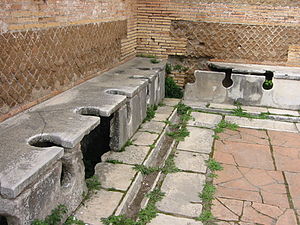Anal hygiene

Under anal hygiene refers to the variety of techniques for the purification of the human anus after defecation . In many cultures, substances are used that are easy to find in the relevant region (sand, leaves, etc.). In the western world today, toilet paper is mostly used.
history
Bronze and Iron Ages
Archaeological excavation finds ( findings ) in one of the oldest salt mines , on the " Salzberg " near Hallstatt, show that the leaves of a butterbur species were probably also used as toilet paper in the Bronze Age or Iron Age . The popular name for the plant is still used in Bavaria today .

Antiquity
The Romans tied a bath sponge to a stick ( xylospongium ) and soaked it in a bucket with salt water .


In ancient Greece and Asia Minor were u. a. flat (pebble) stones in use. Teutons preferred moss , straw and leaves .
middle Ages
In the Middle Ages , moss was used, among other things , the rich indulged in soaked rags and sheep's wool . In archaeological excavations in Burgstall Mole (Mulen) in Heimbuchenthal was found in 2008 in the area of the moat below the former abortion oriel organic radicals fist-sized moss bales that served as toilet paper equivalent.
Outside of Europe
In the Orient one uses (e) water or sponges dipped in water, oriental nomadic peoples still use sand to clean anus. The soaked, paper-like outer shell of corn on the cob was also used in South American cultures, and occasionally gnawed corn on the cob.
The Chinese were the first to use paper on the toilet. Toilet paper was made for the Chinese emperor in 1391. The imperial pension office soon screwed annual production to 720,000 sheets, which were half a square meter rags. Toilet paper is used in most industrialized and emerging countries today .
In India, the Arab world and parts of Southeast Asia, the anus is washed off with the left hand under running water, usually from a cup or hose. Because of this task, the left hand is considered unclean and eating without cutlery (from hand to mouth) is only tolerated with the right hand, even for left-handers.
Especially in toilets in Japan , shower toilets , a combination of toilet and bidet , with heated seats and warm flushing water are widespread with a market share of more than 50 percent. After the damp cleaning, blow-dryers are warm.
process
To prevent anal eczema , wet cleaning is recommended.
When cleaning the anal region after defecation, the wiping direction from the pubic symphysis to the anus is important in order not to colonize the genital area, especially the urethra or vagina, with intestinal bacteria, in order to avoid possible urinary tract inflammation or acute bacterial prostatitis .
literature
- Greg Jenner: News from the day before yesterday. Bastei Lübbe, 2016, ISBN 978-3-732-52323-8 ( limited preview in Google book search).
- Henning Rohde: Teaching atlas of proctology. Georg Thieme Verlag, 2007, ISBN 978-3-131-40881-5 , from page 222 ( limited preview in the Google book search).
See also
Individual evidence
- ^ The Hallstatt depository. The world's oldest salt mine has spectacular finds. Documentation "Terra X" on zdf.de, September 7, 2008 [1]
- ^ Piers D. Mitchell: Human parasites in the Roman World: health consequences of conquering an empire. Parasitology, Volume 144, Special Issue 1 (One Health: parasites and beyond (...)), January 2017, pp. 48–58 [2]
- ↑ Jens Nicolai: ARCHEOLOGY : Findings from the cloaca. In: Der Spiegel. No. 45, 2007 on spiegel.de.
- ^ The archaeological year in Bavaria. Ed. from the Bavarian Office for the Preservation of Monuments by Egon J. Greipl and C. Sebastian Sommer and from the Society for Archeology in Bavaria by Bernd Päffgen. Theiss, Stuttgart 2009. ISBN 978-3-8062-2295-1 . P. 162.
- ↑ Henning Rohde: Teaching Atlas of proctology. Georg Thieme Verlag, 2007, ISBN 978-3-131-40881-5 , p. 229 ( limited preview in Google book search)
- ↑ Christoph Becker: Examen Pflege. Georg Thieme Verlag, 2007, ISBN 978-3-131-41511-0 , p. 244 ( limited preview in the Google book search),
- ↑ Dagmar Dölcker: Guide to alternative practitioners' examination knowledge . Elsevier Health Sciences, 2018, ISBN 978-3-437-09742-3 , p. 406 ( limited preview in Google book search).
- ↑ Richard Hautmann: Urology. Springer-Verlag, 2013, ISBN 978-3-662-22584-4 , p. 162.